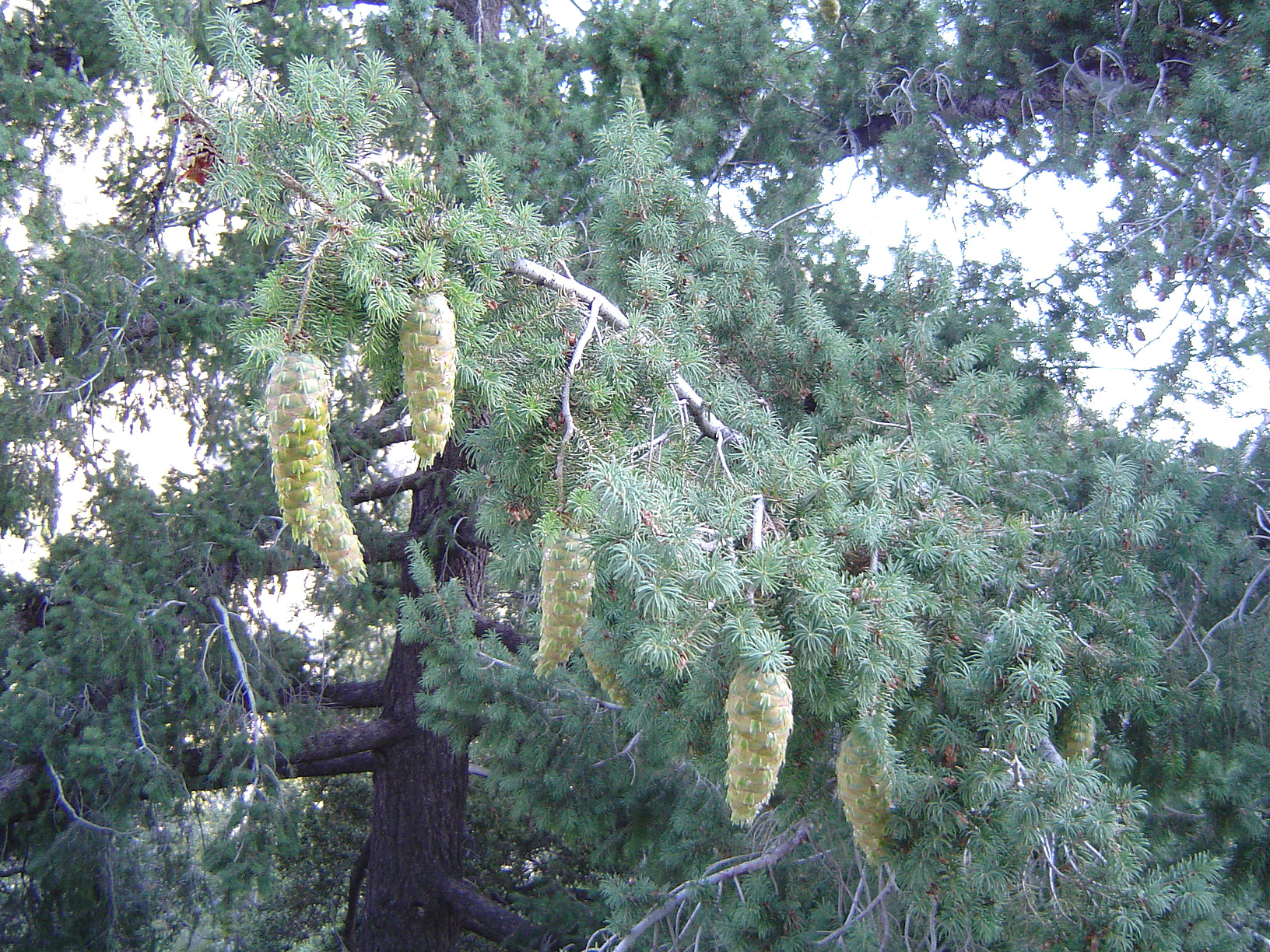- Bigcone Douglas-fir
Taxobox
name = Bigcone Douglas-fir
status = LR/nt | status_system = IUCN2.3

image_width = 250px
image_caption = Bigcone Douglas-fir inMount San Antonio
regnum =Plant ae
divisio =Pinophyta
classis = Pinopsida
ordo =Pinales
familia =Pinaceae
genus = "Pseudotsuga"
species = "P. macrocarpa"
binomial = "Pseudotsuga macrocarpa"
binomial_authority = (Vasey) MayrThe Bigcone Douglas-fir ("Pseudotsuga macrocarpa") is an
evergreen conifer native to the mountains of southernCalifornia , occurring from theSan Rafael Mountains in central Santa Barbara County and the southwest of theTehachapi Mountains of southwestern Kern County, south to Julian in San Diego County. It is notable for having the largest (by far) cones in its genus, hence the name.Characteristics
Bigcone Douglas-fir typically grows from 15-30 m (50-100 feet) in height and 0.5-1.5 m (2-5 feet) in trunk diameter. The growth form is straight, with a conical crown from 12-30 m (40-100 feet) broad, and a strong and spreading root system. The
bark is deeply ridged, composed of thin, woodlike plates separating heavy layers of cork; bark of trees over 1 m (3 feet) in diameter is from 15-20 cm (6-8 inches) thick. The main branches are long and spreading with pendulous side shoots.The leaves are needle-like, 2.5-5 cm (1-2 inches) long, are shed when about 5 years old. The female cones are from 10-18 cm (4-7 inches) long, larger and with thicker scales than those of other
douglas-fir s, and with exserted tridentine bracts. Theseed s are large and heavy, 10 mm long and 8 mm broad, with a short rounded wing 12 mm long; they may bebird ormammal dispersed as the wing is too small to be effective for wind dispersal. Trees start producing seeds at about 20 years of age.The largest known Bigcone Douglas-fir is 53 m (173 feet) tall, 231 cm (91 inches) in diameter, and is estimated to be from 600 to 700 years of age.
[
,_with_a)
Coast Douglas-fir cone for comparison]Range
Bigcone Douglas-fir grows in a Mediterranean climate, characterized by hot dry summers and wet, mild winters. Annual rainfall during a 30-year period on a Bigcone Douglas-fir site in the
San Gabriel Mountains averaged 75 cm (30 inches) and ranged from 25-125 cm (10-50 inches). Bigcone Douglas-fir occurs between 300-2,700 m (1,000-8,000 feet). At low elevation, it occurs near streams in moist, shaded canyons and draws where aspects are mostly north and east. At elevations from 1,350-1,700 m (4,440-5,600 feet), aspects include south- and east-facing slopes. At these elevations, it also grows on sloping hillsides, ridges, and benches. At higherelevation s, it occurs on south and west aspects on all types of terrain. The average angle ofslope on which it grows is 35 degrees, ranging from level to 90 degrees, although these extremes are uncommon.Ecology
Bigcone Douglas-fir has several design features to tolerate and survive
wildfire , notably the very thick bark, and the presence of numerous adventitious buds on the upper side of the branches; this enables the trees to survive even crown fires which burn off all the branchlets, the apparently dead trees becoming green again the following spring. Wildfire frequencies in thechaparral habitats in which Bigcone Douglas-fir often grows typically range from 15-50 year intervals. Bigcone Douglas-fir is closely associated with canyon live oak ("Quercus chrysolepis") and often establishes itself in its shade; after about 50 years, it emerges above the oak canopy.The number of plant associates in Bigcone Douglas-fir communities is usually small. Common overstory associates include
Bigleaf Maple ("Acer macrophyllum"), California Bay Laurel ("Umbellularia californica"),Gray Pine ("Pinus sabineana"), andWhite Alder ("Alnus rhombifolia").Shrub associates include Bigpod Ceanothus ("Ceanothus megacarpus"), Red shank ("Adenostoma sparsifolium"), Eastwood Manzanita ("Arctostaphylous glandulosa"),Toyon ("Heteromoles arbutifolia"), several species of sage ("Salvia"), andCalifornia scrub oak ("Quercus dumosa").Ground cover is usually sparse and may include California buckwheat ("Eriogonum fasciculatum"), wild onion ("Allium" spp.), Scarlet beardtongue ("Penstemon ternatus"),
Chainfern ("Woodwardia fimbriata"), and Western bracken ("Pteridium aquilinium" var. "pubescens").Bigcone Douglas-fir populations are currently stable, with favorable rates of reproduction. The tree is being considered for more extensive plantings in semiarid locales. Its favorable qualities include resistance to drought, fire,
insect s, decay, and damage fromozone . The needles of older trees sometimes fade to yellow, drop, and trees appear dead only to sprout with renewed vigor within 2 years. The reason is unknown, although drought or insects may be possible causes.Uses
There is no current commercial market for Bigcone Douglas-fir wood due to limited distribution and access. It is heavy, hard, and fine grained but not durable. There is less sapwood than heartwood, and the latter contains pockets of resin. In the past, the wood was used locally for fuel and
lumber . Bigcone Douglas-fir stands provide habitat forBlack-tailed Deer , Black Bear, and various small animals. These trees provide preferred spring habitat for Black Bear in theSan Bernardino Mountains . The seeds are eaten by various rodents and birds. Bigcone Douglas-fir is used for watershed restoration. The Los Angeles County Department of Forestry has extensively planted the tree over a 50-year period for that purpose. Some Bigcone Douglas-fir - Douglas-fir ("Pseudotsuga menziesii ") hybrids show promise for outplanting on drier sites in the Douglas-fir region. These hybrids produce wood of comparable quality to that of Douglas-fir and have the drought tolerance of Bigcone Douglas-fir.Before the
douglas-fir s were described as a distinctgenus in1867 , Bigcone Douglas-fir was commonly called Bigcone Spruce; this name, though confusing (it is not aspruce ) is still occasionally used.References
*
* [http://www.conifers.org/pi/ps/macrocarpa.htm Gymnosperm Database: "Pseudotsuga macrocarpa"]
* [http://www.fs.fed.us/database/feis/plants/tree/psemac/index.html US Forest Service Fire Effects Database]
* [http://www.na.fs.fed.us/spfo/pubs/silvics_manual/Volume_1/pseudotsuga/macrocarpa.htm Bigcone Douglas-Fir]
Wikimedia Foundation. 2010.
